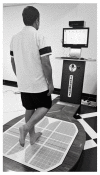Mediation Effect of Pain on the Relationship between Kinesiophobia and Postural Control: Comparison and Correlations in Individuals with Fibromyalgia Syndrome and Asymptomatic Individuals-A Cross-Sectional Study
- PMID: 36676124
- PMCID: PMC9861203
- DOI: 10.3390/life13010175
Mediation Effect of Pain on the Relationship between Kinesiophobia and Postural Control: Comparison and Correlations in Individuals with Fibromyalgia Syndrome and Asymptomatic Individuals-A Cross-Sectional Study
Abstract
Background: Individuals with fibromyalgia syndrome (FM) usually present with a fear of movement (kinesiophobia), which causes their symptoms to be maintained and exacerbated. Kinesiophobia can significantly impact postural control; ascertaining their association is crucial in evaluating and managing individuals with FM. This study aims to (1) compare postural control between individuals with FM and asymptomatic individuals, (2) estimate the relationship between kinesiophobia and postural control in individuals with FM, and (3) evaluate whether pain intensity mediates the association between kinesiophobia and postural control in individuals with FM. Methods: This study enrolled 92 individuals (mean age: 51.52 ± 7.7 years) diagnosed with FM and 106 asymptomatic individuals (mean age: 50.47 ± 6.6 years). The examiners estimated the fear of movement and the intensity of pain utilizing the Tampa scale of kinesiophobia (TSK) scores and the visual analogue scale (VAS), respectively. The postural control variables included anteroposterior (A-P) sway in mm, medio-lateral (M-L) sway in mm, and ellipse area in mm2. Results: The individuals with FM had impaired postural control compared to the asymptomatic individuals (p < 0.001). Kinesiophobia exhibited mild-to-moderate correlations with the postural control variables (nondominant side: A-P sway: r = 0.48, M-L sway: r = 0.49, ellipse area: r = 0.43. Dominant side: A-P sway: r = 0.41, M-L sway: r = 0.33, ellipse area: r = 0.44). The pain intensity significantly mediated the relationship between kinesiophobia and postural control (p < 0.001). Conclusion: Kinesiophobia showed a significant positive relationship with postural control. The individuals with FM with higher TSK scores had decreased postural control. Pain intensity mediated the relationship between kinesiophobia and postural control. These factors must be considered when evaluating and formulating treatment strategies for people with FM.
Keywords: fear of movement; fibromyalgia; kinesiophobia; pain; postural control.
Conflict of interest statement
The authors declare no conflict of interest.
Figures
Similar articles
-
Mediation Effect of Kinesiophobia on the Relationship between Cervical Joint Position Sense and Limits of Stability in Individuals with Fibromyalgia Syndrome: A Cross-Sectional Study Using Mediation Analysis.J Clin Med. 2023 Apr 9;12(8):2791. doi: 10.3390/jcm12082791. J Clin Med. 2023. PMID: 37109128 Free PMC article.
-
Relationship between Kinesiophobia and Ankle Joint Position Sense and Postural Control in Individuals with Chronic Ankle Instability-A Cross-Sectional Study.Int J Environ Res Public Health. 2022 Feb 27;19(5):2792. doi: 10.3390/ijerph19052792. Int J Environ Res Public Health. 2022. PMID: 35270483 Free PMC article.
-
A cross-sectional survey assessing sources of movement-related fear among people with fibromyalgia syndrome.Clin Rheumatol. 2015 Jun;34(6):1109-19. doi: 10.1007/s10067-014-2494-5. Epub 2014 Jan 31. Clin Rheumatol. 2015. PMID: 24481649
-
The association of fear of movement and postural sway in people with low back pain.Front Psychol. 2022 Nov 18;13:1006034. doi: 10.3389/fpsyg.2022.1006034. eCollection 2022. Front Psychol. 2022. PMID: 36467232 Free PMC article.
-
The effects of kinesiophobia on outcome following total knee replacement: a systematic review.Arch Orthop Trauma Surg. 2020 Dec;140(12):2057-2070. doi: 10.1007/s00402-020-03582-5. Epub 2020 Aug 24. Arch Orthop Trauma Surg. 2020. PMID: 32839826
Cited by
-
A Cross-Sectional Study Investigating Lumbar Proprioception Impairments in Individuals with Type 2 Diabetes Mellitus: Correlations with Glycated Hemoglobin Levels.Biomedicines. 2023 Jul 23;11(7):2068. doi: 10.3390/biomedicines11072068. Biomedicines. 2023. PMID: 37509707 Free PMC article.
-
The Mediation Effect of Pain on the Relationship between Kinesiophobia and Lumbar Joint Position Sense in Chronic Low Back Pain Individuals: A Cross-Sectional Study.Int J Environ Res Public Health. 2023 Mar 15;20(6):5193. doi: 10.3390/ijerph20065193. Int J Environ Res Public Health. 2023. PMID: 36982105 Free PMC article.
-
Quadriceps Strength, Postural Stability, and Pain Mediation in Bilateral Knee Osteoarthritis: A Comparative Analysis with Healthy Controls.Diagnostics (Basel). 2023 Oct 1;13(19):3110. doi: 10.3390/diagnostics13193110. Diagnostics (Basel). 2023. PMID: 37835853 Free PMC article.
-
Mediation Effect of Kinesiophobia on the Relationship between Cervical Joint Position Sense and Limits of Stability in Individuals with Fibromyalgia Syndrome: A Cross-Sectional Study Using Mediation Analysis.J Clin Med. 2023 Apr 9;12(8):2791. doi: 10.3390/jcm12082791. J Clin Med. 2023. PMID: 37109128 Free PMC article.
-
Age-Related Decline in Cervical Proprioception and Its Correlation with Functional Mobility and Limits of Stability Assessed Using Computerized Posturography: A Cross-Sectional Study Comparing Older (65+ Years) and Younger Adults.Healthcare (Basel). 2023 Jul 3;11(13):1924. doi: 10.3390/healthcare11131924. Healthcare (Basel). 2023. PMID: 37444758 Free PMC article.
References
-
- Alshahrani M.S., Reddy R.S.Y., Tedla J.S. Effectiveness of Hydro-Galvanic Bath Therapy on Global Health Status, Quality of Life, Depression, and Pain in Individuals with Fibromyalgia–A Quasi-Experimental Study. Phys. Med. Rehabil. Kurortmed. 2020;30:370–376. doi: 10.1055/a-1137-0054. - DOI
-
- Alshahrani M.S., Tedla J.S., Reddy R.S., Asiri F. Effectiveness of Hydrogalvanic Bath on Improving Pain, Disability, and Quality of Life in Individuals with Chronic Nonspecific Neck Pain: A Randomized Controlled Trial. Evid. Based Complement. Altern. Med. 2020;2020:7974816. doi: 10.1155/2020/7974816. - DOI - PMC - PubMed
Grants and funding
LinkOut - more resources
Full Text Sources




